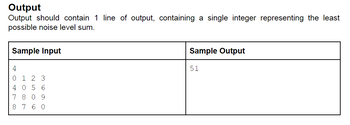
I need help writing this code in C without using the <limits.h> library.
Problem: Given a list of noises generated by all pairs of animals, determine the least sum of noise that can be generated.
Input will begin with a line containing 1 integer, n (1 ≤ n ≤ 11), representing the number of
animal exhibits. The following n lines will each contain n space separated non-negative
integers, representing the noises generated by animal pairs. The i-th value on the j-th line
represents the noise level generated by animal j when antagonized by animal i. Each of the
given individual noise levels generated will be at most 1,000,000. The i-th value of the i-th line will always be 0. Animals don’t generate noise from themselves.
Output should contain 1 line of output, containing a single integer representing the least
possible noise level sum.

Trending nowThis is a popular solution!
Step by stepSolved in 2 steps with 3 images

- Hello I am really really struggling with this problem because i don't know how to do this problem or how to answer this question can you please help me answering this problem. I added the text below. question that I need help with: 1.48 Let Σ = {0,1} and let D = {w|w contains an equal number of occurrences of the substrings 01 and 10}. Thus 101 ∈ D because 101 contains a single 01 and a single 10, but 1010 6∈ D because 1010 contains two 10s and one 01. Show that D is a regular language.arrow_forwardI need help starting this program in C Problem Given a list of newline-separated park sections and an animal pattern (as a letter sequence), find out howmany times the pattern occurs in each park section. Input will begin with a line containing 2 tokens, S and N (1 ≤ |S| ≤ 20; 1 ≤ N ≤ 100,000), representing thetarget animal pattern and the number of sections to process respectively. All characters in S will be eitherupper or lower case latin letters. The following N lines will contain a sequence of characters representinga scanned section of the park. Each park section will contain at most 100,000 characters (letters andspaces; not including the new line at the end of the line). Output should contain N lines. Each line will contain a single integer representing the number ofoccurrences of the letter sequence for the given section. NOTE: You do not need to wait to print out thenumbers. You can print the number after each line of input.arrow_forwardPlease help mearrow_forward
- Exp2: A vectory is given by X = [−3.5 −5 6.2 11 0 8.1 −9 0 3 −1 3 2.5] Using conditional statement and loops, develop a program that creates two vectors from X: Vector P contains all positive elements of X Vector N contains the negative elements of X. The elements in new vectors are in the same order as in X. Please show me how to code this on matlab. I have tried watching tutorials on youtube and can not figure out how to code this for the life of me. Thank you.arrow_forwardPython Your class announced a new grade policy: any of your quiz score that are less than 80 will have 2 points added to them.You decide to check whether the proposed grade replacement policy changes your overall quiz grade. Write a function grade_change that takes as input* a list of quiz grades* a list of letter grade cutoffsand returns the two average scores (before and after the policy) and their corresponding letter grades packaged as a list of tuples using the following order: [(avg1, letter1), (avg2, letter2)]First, you need to * compute the average score of the quiz grades* call the get_letter_grade to get the letter grade for the current average* find the quiz scores that are less than 80 in the list and increment each by 2* recompute the average score* call the get_letter_grade to get the letter grade for the new averageFinally, you return the requested result. Just to help you test your code, here's the main program and its output:if __name__ == "__main__":…arrow_forward
 Database System ConceptsComputer ScienceISBN:9780078022159Author:Abraham Silberschatz Professor, Henry F. Korth, S. SudarshanPublisher:McGraw-Hill Education
Database System ConceptsComputer ScienceISBN:9780078022159Author:Abraham Silberschatz Professor, Henry F. Korth, S. SudarshanPublisher:McGraw-Hill Education Starting Out with Python (4th Edition)Computer ScienceISBN:9780134444321Author:Tony GaddisPublisher:PEARSON
Starting Out with Python (4th Edition)Computer ScienceISBN:9780134444321Author:Tony GaddisPublisher:PEARSON Digital Fundamentals (11th Edition)Computer ScienceISBN:9780132737968Author:Thomas L. FloydPublisher:PEARSON
Digital Fundamentals (11th Edition)Computer ScienceISBN:9780132737968Author:Thomas L. FloydPublisher:PEARSON C How to Program (8th Edition)Computer ScienceISBN:9780133976892Author:Paul J. Deitel, Harvey DeitelPublisher:PEARSON
C How to Program (8th Edition)Computer ScienceISBN:9780133976892Author:Paul J. Deitel, Harvey DeitelPublisher:PEARSON Database Systems: Design, Implementation, & Manag...Computer ScienceISBN:9781337627900Author:Carlos Coronel, Steven MorrisPublisher:Cengage Learning
Database Systems: Design, Implementation, & Manag...Computer ScienceISBN:9781337627900Author:Carlos Coronel, Steven MorrisPublisher:Cengage Learning Programmable Logic ControllersComputer ScienceISBN:9780073373843Author:Frank D. PetruzellaPublisher:McGraw-Hill Education
Programmable Logic ControllersComputer ScienceISBN:9780073373843Author:Frank D. PetruzellaPublisher:McGraw-Hill Education





